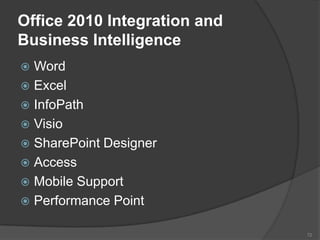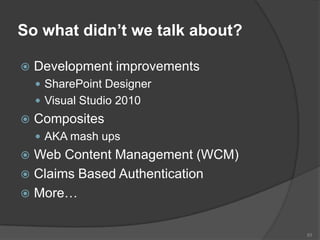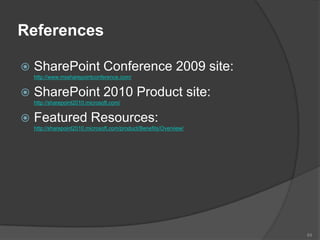Ad
SharePoint Overview
- 1. Introducing Microsoft OfficeSharePoint ServerAmy Phillipshttp://amydphillips.com
- 2. ObjectivesWhat is Sharepoint?Key capabilitiesWhy use Sharepoint?Differences between Sharepoint and WSSSharepoint versions (WSS, Standard, Enterprise)AdministrationDeployment modelsHow to buy Sharepoint
- 3. TriviaHow busy are you?
- 4. Trivia # 1How much data does a typical worker produce in a year?100 megabytes500 megabytes1 gigabyte3 gigabytes
- 5. AnswerHow much data does a typical worker produce in a year?100 megabytes500 megabytes1 gigabyte3 gigabytesSource: “The Enterprise Workplace,” IDC, 2005
- 6. Trivia #2What percentage of a typical workers day is spent searching for information?1 percent10 percent 30 percent60 percent
- 7. AnswerWhat percentage of a typical workers day is spent searching for information?1 percent10 percent30 percent60 percentSource: IDC, 2003
- 8. Trivia # 3How much does lost productivity cost per year for 1,000 employees? $100,000$1 million$5 million$10 million
- 9. AnswerHow much does that lost productivity cost a 1,000 employee company in a year?$100,000$1 million$5 million$10 millionSource: “Hidden Costs of Information Work,” IDC, 2006
- 10. What is Sharepoint?Server side application structure that binds client side output into manageable, searchable, and accessible information.Microsoft branded software that enables a web site to provide document and information sharingProvides templates so that workgroups can share documents, calendars, announcements and postingsAllows the building of internet, intranet and extranet portal environmentsRuns on Windows server operating systems
- 11. What is Sharepoint?Microsoft’s definitionintegrated suite of server capabilities that can help improve organizational effectiveness by providing comprehensive content management and enterprise search, accelerating shared business processes, and facilitating information-sharing across boundaries for better business insightOffice SharePoint Server 2007 supports all intranet, extranet, and Web applications across an enterprise within one integrated platform, instead of relying on separate fragmented systems.Additionally, this collaboration and content management server provides IT professionals and developers with the platform and tools they need for server administration, application extensibility, and interoperability
- 12. EnterpriseOne platform for you, your team, and the companyInternetExtranetDivisionTeamIndividual
- 13. Collaboration &CommunicationsBusinessIntelligenceExtranetEnterpriseProject &PortfolioBusinessProcessIntegration PortalInternetDivisionEnterpriseContentManagementSearchTeamIndividual
- 14. People as MiddlewareCollaborationAd Hoc WorkflowsAnd TasksUnstructuredWorkDocument CreationCoordinate teams & share knowledgeUse data to drive business decisionsSearchSimplify access to business applicationsAutomate business processTraditional ITInvestmentsERPCRMRelationalDatabaseManage content with security & complianceSearchFind and use informationProcessesEnterpriseAppsHard Drivesand File SharesStructuredData
- 15. SharePoint Server 2007Publish documents, task lists, wikis, blogs
- 16. Outlook sync
- 17. Gantt chartsSharePoint Server 2007Enterprise Portal
- 18. MySitesSharePoint Server 2007Search for content, people, expertiseSharePoint Server 2007Create and manage documents, records and Web content
- 19. Slide librariesSharePoint Server 2007Create workflows
- 21. InfoPath formsSharePoint Server 2007Excel services
- 22. KPIs/dashboards
- 23. Role-based MySitesHow it all works togetherEnterprise Content ManagementMake it simple to author and managecontent and documentsKnowledge Discovery and InsightMake the right informationavailable to more peopleCollaborationKeep co-workers, partnersand customers in syncPersonalProductivityIncrease employee self-sufficiency andeffectivenessInformationWorker SolutionsBuild client and web-basedapplications with workflow and line-of-business interoperability Fundamentals Make it more secure, manageable and reliable
- 24. How it helpsMake collaboration easy and intuitiveProvide in-context and role-based informationPortalSolutionsCollaborativeSolutionsMake informed decisions through better insights into business dataContent Management SolutionsBusiness Intelligence SolutionsManage the full content life cycleSearchForms SolutionsConnect people with the information and peopleCapture business dataand automate processesProvide an extensible foundation for customers and partnersProvide a single intranet, extranet and Internet architecture
- 25. Microsoft Office SharePoint Server 2007 Enterprise Features
- 26. Why Office SharePoint Server?Great web content managementComplete design controlAll of the ASP.NET functionalityRich stack of platform investmentsBuilt in Collaboration featuresInternet performance and scale
- 27. Key FeaturesCollaborationCommunity InteractivityEnterprise Content ManagementFormsBusiness IntelligenceSearch
- 30. Manage virtual teamsKey FeaturesPresence integration
- 33. Office IntegrationWindows Sharepoint Services
- 34. CollaborationTeam CollaborationWorkspacesWorker toolsBlogsWikisKeeping track with notificationsSending email to sharepointWorking offline with Outlook
- 35. Key FeaturesCollaborationCommunity InteractivityEnterprise Content ManagementFormsBusiness IntelligenceSearch
- 36. Community InteractivityClose the loop with your customersBuild a communitySupport for collaboration featuresRSS on everythingBlogsWikisDiscussion Boards
- 37. Key FeaturesCollaborationCommunity InteractivityEnterprise Content ManagementFormsBusiness IntelligenceSearch
- 38. ECMInformation workers need tools to manage the entire lifecycle of content from the time it is created to when it is published and finally disposed or stored for long term archivalIntegrated solution to manage the complete content lifecycleReview/ ApproveDisposePublishManageArchiveAuthorEnable authoring /information capture with review/approval capabilitiesCentrally managed repositories with retention/auditing policies, metadata and security Integrated intranet, extranet and internet publishing capabilitiesContent Type = Metadata + Behavior
- 39. Scanner or Multi-function deviceOfficeTeam SitesFormsECM - Document ManagementStorage and retrieval of electronic data filesReuse and protect knowledge assetsFacilitate structured document authoring and collaborationIntegrated content and business processesDocumentRepositoryCheck in / Checkout
- 41. Metadata
- 42. Content approval
- 43. Workflow
- 45. AuditingClaimsSalesEmploymentWorkflow /Business ProcessesAsia Pacific RegionContractsWeb
- 46. Scanner or Multi-function deviceOfficeTeam SitesFormsECM - Records ManagementInformation created, received, and maintained as evidence in pursuance of legal obligations or in the transaction of businessReduce risk of non-compliance and legal liabilityRetain vital records for business continuityReduce costs of retrieving information for legal discoveryConfigure repository as per file plan
- 47. Capture and categorize business records
- 48. Auditing, expiration and retention policies (defined by regulations or business policies)
- 49. Hold capabilities in case of litigationMortgage ContractsFinancialsRecords ManagerRecords RepositoryAsia Pacific RegionWeb
- 50. ECM - Web Content ManagementAuthoring and publishing system to empower non-technical content authors to manage a web siteGive business users the power to author and publish web content in a timely mannerUtilize brand assets more effectivelyLower the cost of managing multiple site and multilingual deliverySeparation of content and presentation
- 51. Authoring: (HTML Editor / Office)
- 52. Built in review/approval workflow
- 53. Site variations
- 55. Deployment systemWeb Content RepositoryContentHTML Web PagesTemplatesSite DevelopersTemplate designersGraphics DesignersContentAuthors
- 56. Web Content Management FeaturesBrandingSeparating content from presentationPage AuthoringWeb basedClient: WordSite NavigationGovernancePublishing schedulesApproval workflowFormatting restrictionsSite management toolsPerformanceInternet scaleCachingContent DeploymentSecurityForms authenticationAnonymous accessMulti-lingual sitesSearch integration
- 57. Key FeaturesCollaborationCommunity InteractivityEnterprise Content ManagementFormsBusiness IntelligenceSearch
- 58. Business Process IntegrationOrganizations need tools to define a collection of related structural activities that produce something of value and/or ensure complianceInformation workers need tools to enable them to easily undertake these activities providing appropriate inputs and handling the outputs.OrchestrationIntegrationForms
- 59. WorkflowWorkflow5 Out of the box workflowsReporting for Enterprise Content ManagementWindows Workflow FoundationCreate and maintain workflow withSharepoint designerVisual Studio
- 60. Workflow – approvals example
- 61. Official RecordsArchive/ReviewReady to publish,sign off & approvePublishCreateFull Document Process
- 62. Key FeaturesCollaborationCommunity InteractivityEnterprise Content ManagementFormsBusiness IntelligenceSearch
- 63. Business IntelligenceInformation workers need tools to make well informed business decisions and enable competitive advantage.Business Insight Dashboards, KPI web partsBrowser based access to spreadsheet functionalityConnect to OLAP cubes / SQL 2005 Analysis ServicesDrive Business PerformancePerformance management process through personalized Web-based scorecardsAdvanced analytic and data visualization capabilitiesPlanning, budgeting and forecastingMicrosoftOffice PerformancePointServer 2007
- 64. Key FeaturesCollaborationCommunity InteractivityEnterprise Content ManagementFormsBusiness IntelligenceSearch
- 65. FindUseShareSearchInformation workers need tools to quickly locate relevant information from diverse data sources. Organizations need to protect sensitive information.DesktopSearchWindowsDesktop SearchFree downloadBuilt-inEnterpriseSearchFind information across the desktop, intranet and InternetUse information via intuitive, familiar interfacesShare information among teams and connect people in real-timePeopleInternetSearch
- 66. Search SummarySearchBusiness DataExtensibleCustomizableSearch enterprise contentSearch people across enterpriseText search for team sitesBest bets, key words, etc
- 67. WSS vs MOSSWSS 3.0StandardEnterpriseInternetSearch
- 68. PlatformServicesWorkspaces, Mgmt,Security, Storage,Topology, Site ModelWindows SharePoint Services version 3Server-based Excel spreadsheets and data visualization, Report Center, BI Web Parts, KPIs/DashboardsDocs/tasks/calendars, blogs, wikis, e-mail integration, project management “lite”, Outlook integration, offline docs/listsBusinessIntelligenceCollaborationEnterprise Portal template, Site Directory, My Sites, social networking, privacy controlRich and Web forms based front-ends, LOB actions, enterprise SSOBusinessFormsPortalContentManagementSearchIntegrated document management, records management, and Web content management with policies and workflowEnterprise scalability,contextual relevance, rich people and business data search
- 69. PlatformServicesWorkspaces, Mgmt,Security, Storage,Topology, Site ModelSharepoint Server 2007 - StandardServer-based Excel spreadsheets and data visualization, Report Center, BI Web Parts, KPIs/DashboardsDocs/tasks/calendars, blogs, wikis, e-mail integration, project management “lite”, Outlook integration, offline docs/listsBusinessIntelligenceCollaborationEnterprise Portal template, Site Directory, My Sites, social networking, privacy controlRich and Web forms based front-ends, LOB actions, enterprise SSOBusinessFormsPortalContentManagementSearchIntegrated document management, records management, and Web content management with policies and workflowEnterprise scalability,contextual relevance, rich peopleand business data search
- 70. PlatformServicesWorkspaces, Mgmt,Security, Storage,Topology, Site ModelSharepoint Server 2007 – EnterpriseServer-based Excel spreadsheets and data visualization, Report Center, BI Web Parts, KPIs/DashboardsDocs/tasks/calendars, blogs, wikis, e-mail integration, project management “lite”, Outlook integration, offline docs/listsBusinessIntelligenceCollaborationEnterprise Portal template, Site Directory, My Sites, social networking, privacy controlRich and Web forms based front-ends, LOB actions, enterprise SSOBusinessFormsPortalContentManagementSearchIntegrated document management, records management, and Web content management with policies and workflowEnterprise scalability,contextual relevance, rich people and business data search
- 71. PlatformServicesWorkspaces, Mgmt,Security, Storage,Topology, Site ModelSharepoint Server 2007 – For Internet SitesServer-based Excel spreadsheets and data visualization, Report Center, BI Web Parts, KPIs/DashboardsDocs/tasks/calendars, blogs, wikis, e-mail integration, project management “lite”, Outlook integration, offline docs/listsBusinessIntelligenceCollaborationEnterprise Portal template, Site Directory, My Sites, social networking, privacy controlRich and Web forms based front-ends, LOB actions, enterprise SSOBusinessFormsPortalContentManagementSearchIntegrated document management, records management, and Web content management with policies and workflowEnterprise scalability,contextual relevance, rich people and business data search
- 72. Feature Areas by ProductSharepoint feature areasLibrariesListsPagesPortalsSitesWorkflow
- 73. Feature Areas by ProductLibrariesWSS vs. MOSSReport LibTranslation Management LibData Connection LibSlide LibDocument LibForm LibWiki Page LibPicture Lib
- 74. Feature Areas by ProductListsWSS vs. MOSSKPIAnnouncementsContactsDiscussionCalendarLinksProject TasksIssue TrackingSurveysCustomImport from Spreadsheet
- 75. Feature Areas by ProductPagesWSS vs. MOSSPublishing PageDashboard PageBasic PageWeb part page
- 76. Feature Areas by ProductPortalsWSS vs. MOSSCollaborationPublishingMy SitesInternet
- 77. Feature Areas by ProductSitesWSS vs. MOSSDocument CenterReport centerRecords centerSearch CenterPublishing SiteSite DirectoryPersonalization siteTeam SiteDocument workspaceMeeting workspaceWikiBlog
- 78. Feature Areas by ProductWorkflowsWSS vs. MOSSApprovalCollect feedbackCollect signatureDisposition Approval3 state3 state
- 79. Accessing SharepointClient IntegrationWord 2003/2007Excel 2003/2007Outlook 2003/2007Access 2003/3007PowerPoint 2007InfoPath 2007
- 80. Accessing SharepointURL access http://serverBrowsers (IE, Firefox, Safari)Office 2007 ClientsOffice 2003 ClientsOther windows applicationsMy Network Places
- 81. SharePoint 2010 is an evolution of SharePoint 2007Interface improvementsMore AJAX for quicker page renderingThe Ribbon from Office makes an appearanceOnline editing via Office Web AppsImproved search and integration with FAST64-bit only! But will run on Windows Server 2008 AND Windows 7 (maybe Vista)60
- 82. So what’s new in SharePoint 2010?61
- 83. Microsoft’s six major capabilities areas in SharePoint 201062SitesCommunitiesCompositesContentInsightsSearch
- 84. Microsoft's has bet big with Social ComputingMy Sites are greatly improved – much more like FacebookSocial SearchSearch suggestions (Google/Bing-like drop down)Social tagging and the Managed Metadata Service (taxonomy vs. folksonomy)63
- 85. My Sites contain a lot more content64
- 86. Search results can be much more relevantClick through improves relevancePre and post query suggestionsPeople search has phonetic spell checking65
- 87. Tagging and Ratings can help users find informationAnyone can tagEnterprise terms (taxonomy)User defined terms (folksonomy)Ratings can help search results by improving relevance66
- 88. Owners and Consumers Define the Taxonomy & FolksonomySocial TagsTags input by any userMultiple terms can be storedEntered into tag cloud available to other usersManaged KeywordsTags input by ContributorsSingle term stored in a single listManaged TermsCreated by those with appropriate permissionsUsed for metadata navigation67
- 89. Content OrganizerSet up rules for content routing based on metadata send to different destinationsLibrariesOther SitesRecords Center68
- 90. The MOSS Document Center is Expanded from 2007Manage larger quantities of documents (~500k)Content Queries to show:Newest DocumentsHighest Rated‘Modified by Me’Quick upload and routing of documents through the repositoryUnique, SEARCHABLE Document IDsProvisioned at Site Collection LevelCustomizable with a prefixFollow a document even if it has movedRatings and TagsFilter / sort libraries by ratingQuick tag a document “I Like It”69
- 91. New Document Sets Quickly Provision Groups of DocumentsSet of documents that should be treated as a single entityDoc Set gets unique IDEach doc get a unique IDEach document can still be managed individuallyLaunched with .aspx landing page to allow for management of contentIncreased functionality for documentsAutomated creation of repetitive content WorkflowsShared metadata70
- 92. Records Management that Actually Works!Can define multiple Records CentersIn Place Declaration!Mark items as records in their current locationCopy to archive / repository and leave a link in current locationRetention SchedulingSet up different policies on a folder-by-folder basisReview, delete, hold in place, archive 71
- 93. Office 2010 Integration and Business IntelligenceWordExcelInfoPathVisioSharePoint DesignerAccessMobile SupportPerformance Point72
- 94. Office 2010 Integration – WordEditing and publishing straight to webAbility for multiple users to edit simultaneouslyEditing without client-side application
- 95. Office 2010 Integration – Excel ServicesPowerful Excel integrationLive color-coded updates from multiple users simultaneouslyFull pivot capabilitiesShow/hide what you want
- 96. Office 2010 Integration – InfoPath 2010Create forms in InfoPath. View in email or browser or desktopInfoPath is the new preferred list input UIAttach Visio diagram, attach designer workflow, deploy
- 97. Office 2010 Integration – Visio ServicesPublish Visio documents directly to SharePointRich graphical workflows highlight BPR processesCreate workflows and export to SharePoint DesignerNew SharePoint templates
- 98. SharePoint Designer 2010Powerful and Reusable workflowsAttach workflows to content typesConnecting to external content typesExport to Visio
- 99. Office 2010 Integration – Access ServicesPublishing of legacy Access applications directly to SharePointFull SQL relationship supportNew server side web formsLocal and server copies
- 100. Office 2010 Integration – Mobile SupportFull mobile editing with formatting preservedOnly document changes download; supports users with slow connections
- 102. Central Administration has been revamped81
- 103. Service Applications replace the Shared Service Provider82
- 104. So what didn’t we talk about?Development improvementsSharePoint DesignerVisual Studio 2010Composites AKA mash upsWeb Content Management (WCM)Claims Based AuthenticationMore…83
- 105. ReferencesSharePoint Conference 2009 site:http://www.mssharepointconference.com/SharePoint 2010 Product site:http://sharepoint2010.microsoft.com/Featured Resources:http://sharepoint2010.microsoft.com/product/Benefits/Overview/84
- 106. How to Purchase SharepointSharepoint is only offered through Microsoft Volume licensingRequires the purchase of a server license and Client Access Licenses (CALs)Server license is for running in client / server modeClient CALs can be acquired through Select Licensing, Open Licensing, and Enterprise Agreements
- 107. Questions?
- 108. SharePoint - Extensible PlatformASP.NET 2.0 Web Parts
- 109. MemMaster Pages
- 110. bership
- 111. Navigation
- 112. Caching Internet EditionorStandardCALContent ManagementServicesECM
- 113. Search
- 114. Aggregation
- 115. Discovery
- 116. CollaborationContent ManagementPortal ServicesWindows Workflow FoundationSearch ServicesWindowsCommunication FoundationWeb ServicesExcel ServicesForms
- 117. Calculation / Business Rules
- 118. IntegrationForms ServicesBusiness Data ServicesInternet EditionorEnterpriseCALDocument Management
- 119. List management
- 120. WorkspacesDeployment ScenariosScenario 1 – Single Server MOSS ImplementationNo redundancy.
- 122. Suitable for only the smallest of deployments.Deployment ScenariosScenario 2 – Small Server FarmAdds a second tier.
- 124. No redundancy.Deployment ScenariosScenario 3 – Small Server Farm with RedundancyAdds redundant servers to each tier.
- 125. Improves performance.Deployment ScenariosScenario 4 – Medium Server FarmSeparate Web, Application and Database tier.
- 128. Redundant components can be removed if required.Deployment ScenariosScenario 5 – BaseLarge Server FarmSeparate Web, Application and Database tier.
- 129. Multiple clustered SQL instances.
- 131. Improved performance.Deployment ScenariosScenario 6 – Highly Scaled Large Server FarmSeparate Web, Application and Database tier.
- 134. Redundant components can be removed if required.Multi-Farm TopologyAuthoring FarmProduction FarmInternetContent DeploymentRequests
Editor's Notes
- #61: 64-bit only allows for greater amounts of RAM, which is definitely needed for SharePoint 2010
- #62: A little demo showing off the look and feel
- #66: Just some of the search improvements
- #82: Should be easier to navigate and find things in Central AdministrationRibbon is here too!
- #83: Can run certain service apps on each web application/web front end.Also can build your own service applications.

























































































































































